Vietnamese cuisine is a delightful fusion of fresh herbs, rice noodles, and street food culture, celebrated for its vibrant flavors and aromatic ingredients. Dishes like phở, bánh mì, and gỏi cuốn highlight the importance of fresh herbs, which enhance the taste and freshness of each meal. With a variety of rice noodles, such as bánh phở and bún, Vietnamese food offers a unique culinary experience that reflects the country’s rich heritage.
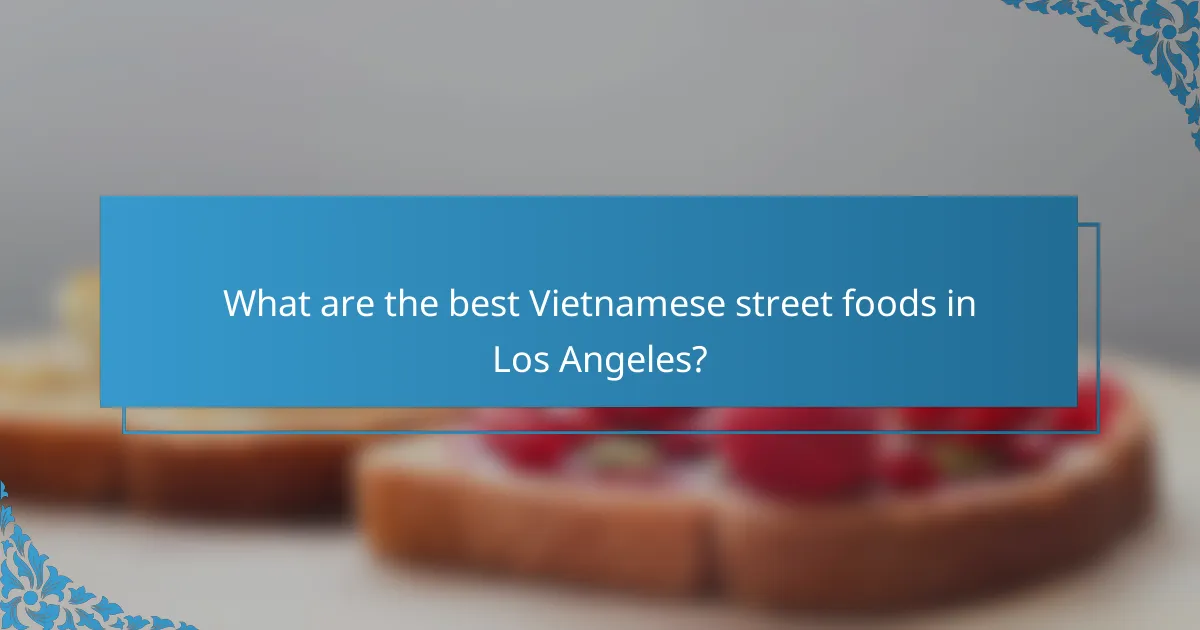
What are the best Vietnamese street foods in Los Angeles?
Los Angeles offers a vibrant selection of Vietnamese street foods, showcasing fresh ingredients and bold flavors. Some of the top choices include phở, bánh mì, and gỏi cuốn, each providing a unique taste of Vietnamese culinary culture.
Phở from Phở 2000
Phở 2000 is renowned for its authentic phở, a traditional Vietnamese noodle soup. The dish features a rich broth, typically made from simmering beef bones, herbs, and spices for several hours, resulting in a complex flavor profile.
When ordering phở, consider customizing it with fresh herbs, lime, and chili to enhance the taste. The restaurant offers various options, including beef, chicken, and vegetarian versions, catering to different preferences.
Bánh mì from Bánh Mì Chè Cali
Bánh mì from Bánh Mì Chè Cali is a must-try for anyone seeking a delicious Vietnamese sandwich. This street food combines a crispy baguette with a variety of fillings, such as grilled meats, pickled vegetables, and fresh herbs, creating a delightful balance of textures and flavors.
For the best experience, opt for their signature pork or chicken bánh mì, which are popular choices. Don’t forget to add chili sauce for an extra kick, and enjoy it as a quick meal on the go.
Gỏi cuốn from The Pho Shop
Gỏi cuốn, or Vietnamese spring rolls, from The Pho Shop are a refreshing and healthy option. These rolls are typically filled with shrimp, fresh vegetables, and vermicelli noodles, all wrapped in rice paper, making them light yet satisfying.
When ordering gỏi cuốn, pair them with a peanut or hoisin dipping sauce for added flavor. They are perfect as an appetizer or a light snack, showcasing the fresh herbs and ingredients that are central to Vietnamese cuisine.
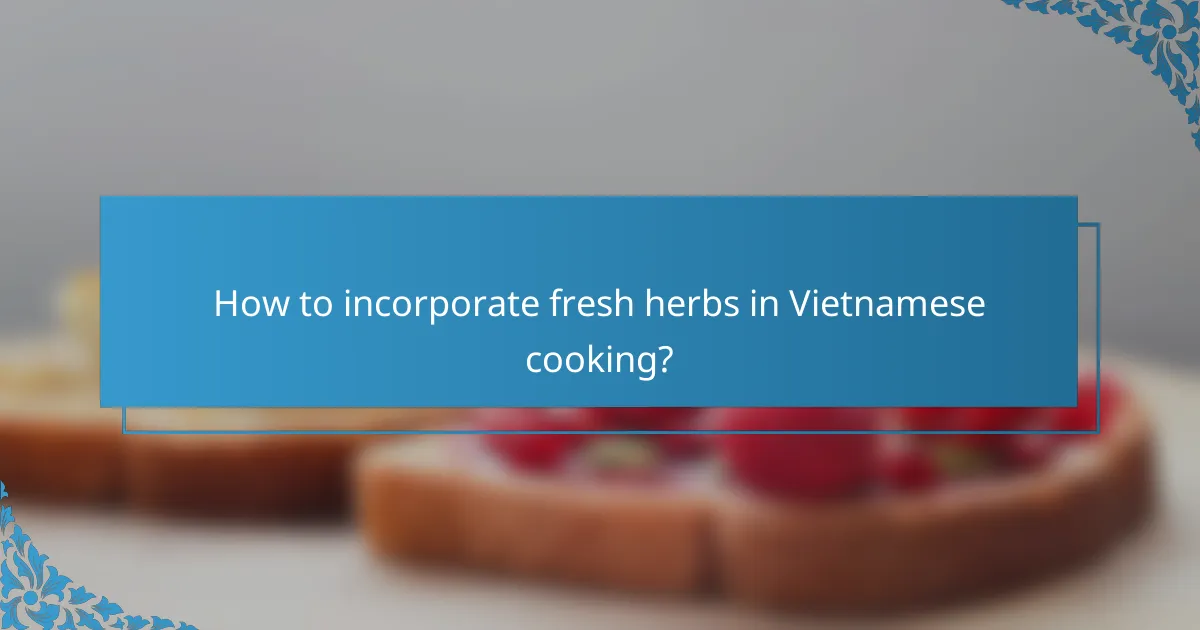
How to incorporate fresh herbs in Vietnamese cooking?
Incorporating fresh herbs in Vietnamese cooking enhances flavor and adds freshness to dishes. Key herbs are often used both as ingredients and garnishes, providing vibrant tastes and aromas that are essential to the cuisine.
Common herbs used in Vietnamese dishes
Vietnamese cuisine features a variety of fresh herbs, each contributing unique flavors. Common herbs include cilantro, mint, basil (especially Thai basil), and perilla. These herbs are often used in salads, soups, and as accompaniments to grilled meats.
Other notable herbs include lemongrass, which adds a citrusy note, and dill, frequently found in dishes like cha ca (grilled fish). Understanding the role of each herb can help in selecting the right ones for your recipes.
Techniques for using herbs
When using fresh herbs in Vietnamese cooking, consider adding them at different stages of the cooking process. For instance, herbs like basil and mint are best added just before serving to maintain their vibrant flavor and texture.
Chopping herbs finely can release more flavor, but be cautious not to over-process them, as this can lead to bitterness. A common practice is to use whole leaves as a garnish, allowing diners to add them according to their taste preferences.
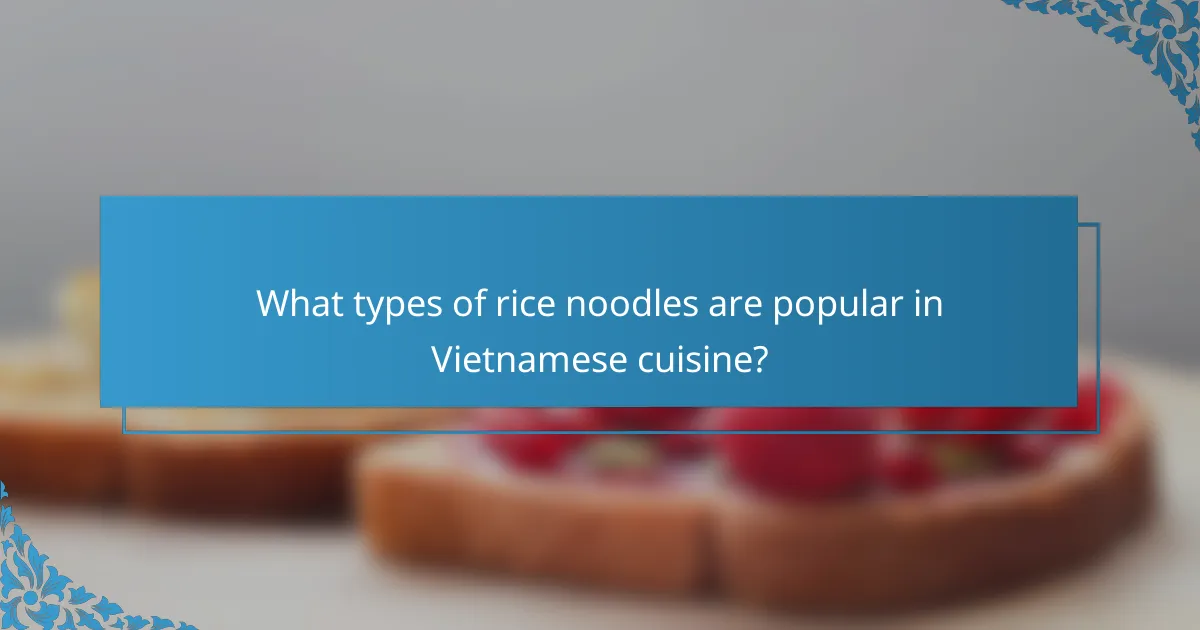
What types of rice noodles are popular in Vietnamese cuisine?
Vietnamese cuisine features several popular types of rice noodles, each with unique characteristics and uses. The most notable varieties include bánh phở and bún, which are integral to many traditional dishes.
Bánh phở (flat rice noodles)
Bánh phở are wide, flat rice noodles commonly used in the famous pho soup. They are typically made from rice flour and water, resulting in a chewy texture that absorbs flavors well.
These noodles are usually served fresh, but dried versions are also available. When cooking, they require a brief soak in hot water to soften before adding to soups or stir-fries.
Bún (vermicelli noodles)
Bún are thin, round rice vermicelli noodles that are versatile in Vietnamese dishes. They are often served cold in salads or warm in soups and stir-fries, making them a staple in many meals.
These noodles are quick to prepare, usually needing just a few minutes of soaking in hot water. Bún pairs well with fresh herbs, grilled meats, and various sauces, enhancing the overall flavor profile of the dish.
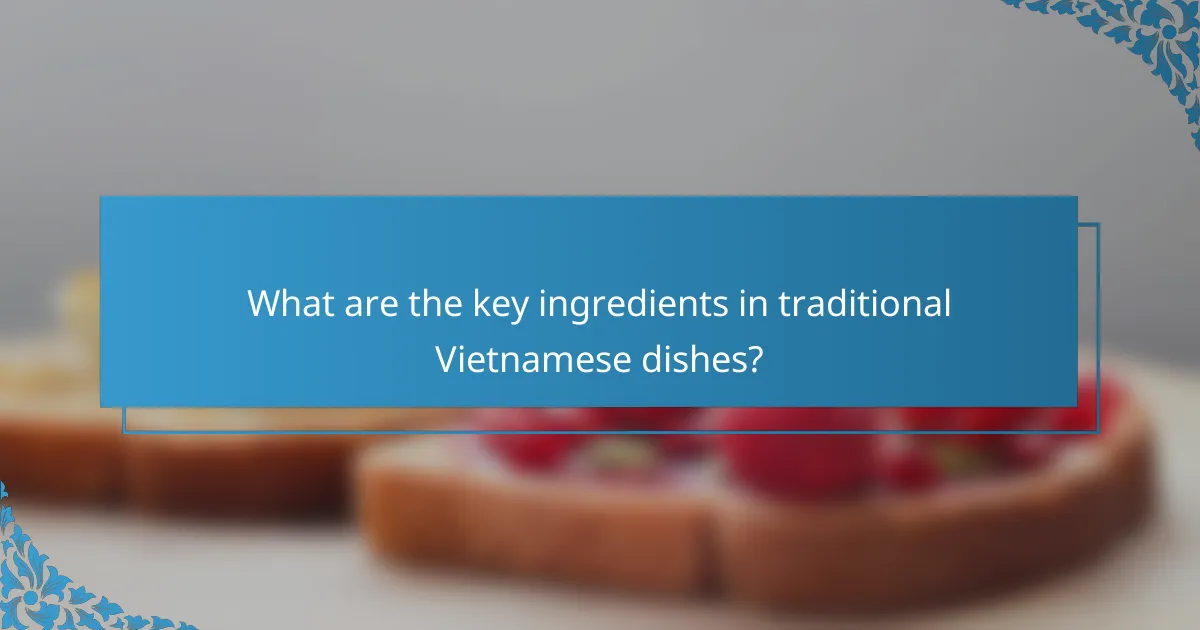
What are the key ingredients in traditional Vietnamese dishes?
Traditional Vietnamese dishes are characterized by fresh herbs, rice noodles, and a variety of proteins, often enhanced by the use of fish sauce. These ingredients create a balance of flavors and textures that define the cuisine.
Fish sauce as a flavor base
Fish sauce, known as “nước mắm,” is a fundamental ingredient in Vietnamese cooking, providing a salty and umami-rich flavor. It is made from fermented fish and is used in marinades, dipping sauces, and soups.
When using fish sauce, it’s important to choose high-quality brands, as the flavor can vary significantly. Look for options that are made from anchovies and have a clear, amber color, indicating a well-crafted product.
Common dishes that feature fish sauce include pho, spring rolls, and various stir-fries. A little goes a long way, so start with small amounts and adjust to taste.
Rice as a staple
Rice is the cornerstone of Vietnamese cuisine, serving as the primary carbohydrate source in most meals. It is typically served steamed or as rice noodles, which are essential in dishes like pho and bun.
Vietnamese rice comes in various forms, including jasmine rice, sticky rice, and rice flour, each used for different culinary purposes. For instance, jasmine rice is often served with meat and vegetables, while rice flour is used to make noodles and pancakes.
When preparing rice, rinsing it before cooking helps remove excess starch, resulting in fluffier grains. Aim for a water-to-rice ratio of about 1.5:1 for optimal cooking results.
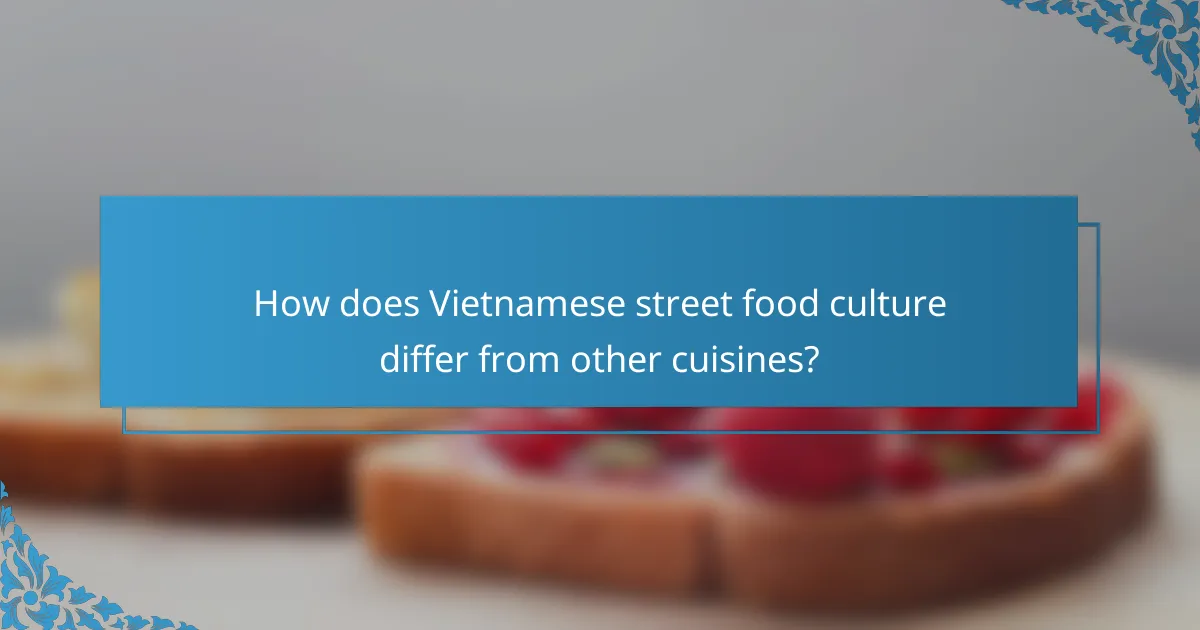
How does Vietnamese street food culture differ from other cuisines?
Vietnamese street food culture is characterized by its vibrant use of fresh ingredients and a communal dining experience that is often enjoyed outdoors. Unlike many other cuisines, it emphasizes quick preparation and accessibility, allowing locals and tourists alike to savor authentic flavors on the go.
Emphasis on fresh ingredients
Fresh herbs, vegetables, and proteins are staples in Vietnamese street food, setting it apart from many other culinary traditions. Dishes often feature ingredients like cilantro, mint, and basil, which enhance flavor and aroma. Street vendors typically prepare food on-site, ensuring that everything is served at peak freshness.
Common dishes such as pho and banh mi showcase this emphasis on fresh ingredients, combining rice noodles or bread with a variety of meats and a generous helping of herbs. This focus not only elevates taste but also contributes to the overall healthiness of the cuisine.
Dining experience on the streets
The dining experience in Vietnamese street food culture is unique, as it often takes place at small, open-air stalls or food carts. Patrons can enjoy their meals while seated on low plastic stools, creating a casual and social atmosphere. This setup encourages interaction among diners and vendors, fostering a sense of community.
Street food is not just about eating; it’s an experience that involves engaging with the local culture. Many vendors have their own specialties, and trying different stalls can lead to discovering a wide range of flavors and cooking styles. This dynamic environment makes Vietnamese street food a lively and integral part of daily life in Vietnam.
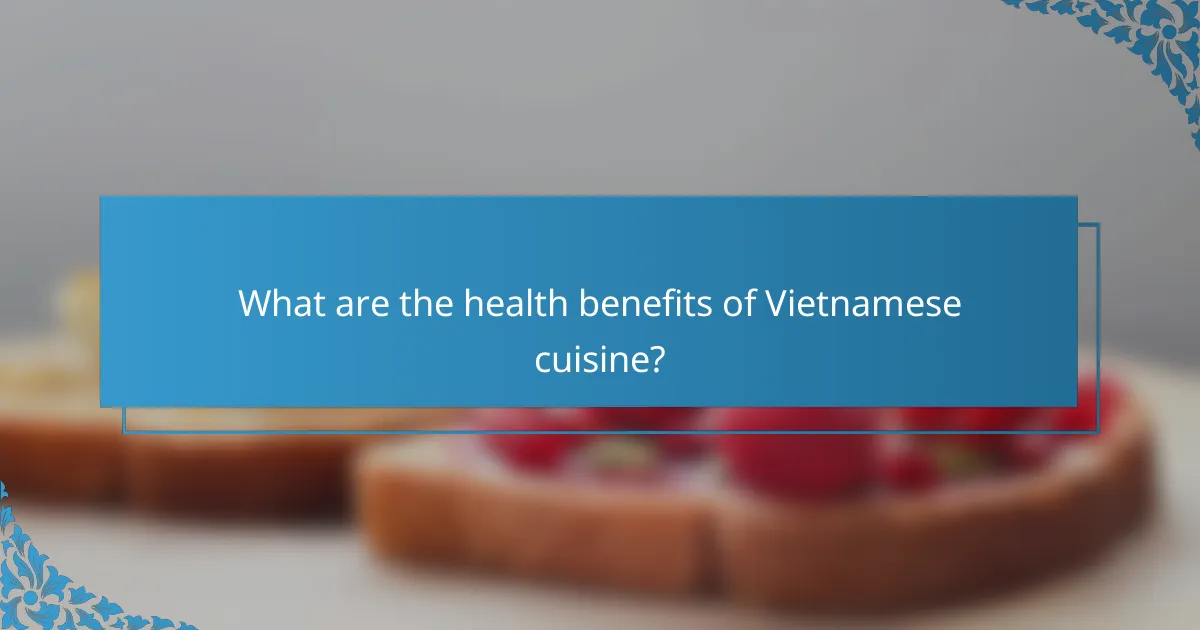
What are the health benefits of Vietnamese cuisine?
Vietnamese cuisine offers numerous health benefits, primarily due to its emphasis on fresh ingredients and balanced flavors. The use of herbs, vegetables, and lean proteins contributes to a nutritious diet that supports overall well-being.
Low in calories
Many traditional Vietnamese dishes are low in calories, making them suitable for those looking to maintain or lose weight. Dishes often feature rice noodles, fresh vegetables, and lean proteins, which provide satisfying meals without excessive calories.
For example, a bowl of pho typically contains around 300-400 calories, depending on the ingredients used. This allows for a filling meal that doesn’t compromise dietary goals.
Rich in nutrients
Vietnamese cuisine is rich in essential nutrients, thanks to its focus on fresh herbs and vegetables. Ingredients like cilantro, mint, and basil not only enhance flavor but also provide vitamins and antioxidants that support health.
Additionally, the use of lean proteins such as chicken, fish, and tofu contributes to a balanced intake of macronutrients. Many dishes are also high in fiber, which aids digestion and promotes a feeling of fullness.
